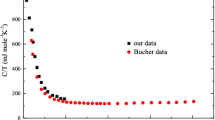Abstract
THE surprisingly high transition temperatures (Tc) for superconductivity in alkali-meta-doped C60 has spurred wide interest in understanding its mechanism1–6. Recently the increase in Tc with lattice constant was demonstrated for these materials6, and was interpreted as resulting from the corresponding increase in the density of states at the Fermi level. According to the standard (BCS) theory of superconductivity, the other important factor controlling Tc is the phonon that mediates electron pairing. To test whether this factor plays a part for the C60 superconductors, we prepared C60 containing various amounts of 13C, which we then doped with rubidium to give Rb3C60. Measurements of diamagnetic shielding and Meissner effect show that Tc decreases as the 13C content increases, as expected within the context of BCS-like phonon-mediated pairing; but the dependence on the mass is stronger than for most electron-phonon superconductors where Tcm−α with α ≤0.5. Instead, the exponent a has the remarkably large value of 1.4±0.5. Regardless of the interpretation of this value, it is clear that phonons have an important role in the origin of superconductivity in doped C60.
Similar content being viewed by others
References
Hebard, A. F. et al. Nature 350, 600–601 (1991).
Holczer, K. et al. Science 252, 1154–1157 (1991).
Rosseinsky, M. J. et al. Phys. Rev. Lett. 66, 2830–2832 (1991).
Tanigaki, K. et al. Nature 352, 222–223 (1991).
Kelly, S. P., Chen, C.-C. & Ueber, C. M. Nature 352, 223–225 (1991).
Fleming, R. M. et al. Nature 352, 787–788 (1991).
Kratchmer, W., Lamb, L. D., Fostiropoulos, K. & Huffman, D. R. Nature 347, 354–358 (1991).
Ebbesen, T. W., Tabuchi, C. & Tanigaki, K. Chem. Phys. Lett. (in the press).
Welp, U., Kwok, W. K., Crabtree, G. W., Vanderroot, K. G. & Lin, J. Z. Phys. Rev. Lett. 62, 1908 (1989).
Barbee, T. W. III, Cohen, M. L. & Penn, D. R. Phys. Rev. B44, 4473 (1991).
Bourne, L. C., Zettl, A., Barbee, T. W. III & Cohen, M. L. Phys. Rev. B36, 3990–3993 (1987).
Zhang, Z., Chen, C.-C., Kelty, S. P., Dai, H. & Lieber, C. M. Nature 353, 333–335 (1991).
Deutscher, G. & Muller, K. A. Phys. Rev. Lett. 59, 1745 (1987).
Holczer, K. et al. Phys. Rev. Lett. 67, 271 (1991).
Tsai, J. S. et al. Phys. Rev. (submitted).
Oshiyama, A. & Saito, S. Phys. Rev. Lett. (submitted).
Author information
Authors and Affiliations
Rights and permissions
About this article
Cite this article
Ebbesen, T., Tsai, J., Tanigaki, K. et al. Isotope effect on superconductivity in Rb3C60. Nature 355, 620–622 (1992). https://doi.org/10.1038/355620a0
Received:
Accepted:
Issue Date:
DOI: https://doi.org/10.1038/355620a0
- Springer Nature Limited
This article is cited by
-
Mechanism of superconductivity in the polyhedral-network compound Ba8Si46
Nature Materials (2003)
-
Evidence for optimal isometric bond order in high-temperature superconductors
Journal of Superconductivity (1997)





